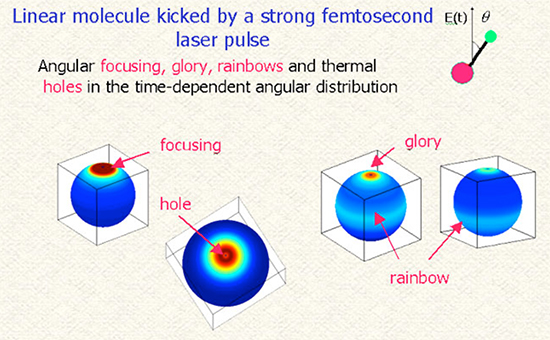The driven rotor is a standard textbook model in nonlinear dynamics research. Together with the harmonic oscillator, it is one of the most studied physical systems. In recent years, we revisited the problem of a kicked rotor in order to find new mechanisms for laser control of molecular rotational states, especially for the process of molecular alignment (orientation) by laser fields. Short and strong laser pulses (several hundred femtoseconds long for typical diatomics, about 1013 W/cm2 in intensity) create molecular rotational wave packets that acquire an aligned shape after the end of the pulse, i.e., at field-free conditions. Such a transient molecular alignment finds numerous applications in the problems of chemical reaction dynamics, surface processing, and ultra-fast optics.
We found that the free evolution of any strongly kicked quantum rotor is subject to several semi-classical catastrophes manifested in the angular distribution singularities. The time-dependent wave function demonstrates spectacular phenomena that have analogs in atmospheric optics: focusing, rainbow, and glory.

As a result of the new understanding of the kicked rotor dynamics, we suggested several practical schemes for the efficient laser control of molecular rotation. In particular, we proposed a method for enhanced molecular alignment using trains of short pulses of moderate intensity, and also a technique for molecular orientation using a combination of femtosecond pulses and asymmetric half-cycle pulses. We designed pulse sequences capable of selective alignment of a preferred species in a molecular mixture, such as a mixture of different isotopes, or different nuclear spin isomers.

Moreover, by manipulating the polarization of the delayed kicking pulses, we suggested a scheme (“molecular propeller”) for exciting unidirectional molecular rotation (clockwise or counterclockwise).

The proposed schemes have been tested and used by numerous experimental groups throughout the world. Several of these techniques were developed and demonstrated experimentally in collaboration with the group of Yehiam Prior from the Weizmann Institute.
- I. Sh. Averbukh and R. Arvieu, “Angular Focusing, Squeezing, and Rainbow Formation in a Strongly Driven Quantum Rotor”, Phys. Rev. Lett. 87, 163601 (2001)
- I. Sh. Averbukh, R. Arvieu, and M. Leibscher, “Controlling quantum rotation with light”,
in Coherent and Quantum Optics VIII (Plenum, 2002) - M. Leibscher, I.Sh. Averbukh and H. Rabitz, “Molecular alignment by trains of short laser pulses",
Phys. Rev. Lett. 90, 213001 (2003) - M. Leibscher, I.Sh. Averbukh and H. Rabitz, “Enhanced molecular alignment by short laser pulses”, Phys. Rev. A 69, 013402 (2004)
- M. Leibscher, I.Sh. Averbukh, P. Rozmej, and R. Arvieu, “Semiclassical catastrophes and accumulative angular squeezing of a kicked quantum rotor”, Phys. Rev. A 69, 032102 (2004)
- S. Fleischer, I. Sh. Averbukh and Y. Prior, “Isotope-selective laser molecular alignment”,
Phys. Rev. A 74, 041403(R) (2006) - E. Gershnabel, I.Sh.Averbukh and R. Gordon, “Orientation of molecules via laser-induced antialignment”, Phys. Rev. A 73, 061401(R) (2006)
- E. Gershnabel, I. Sh. Averbukh and R. Gordon, “Enhanced Molecular Orientation Induced by Molecular Anti-Alignment”, Phys. Rev. A 74, 053414 (2006)
- S. Fleischer, I. Sh. Averbukh, and Y. Prior, “Spinning Molecules Selectively: Laser control of isotopes and nuclear spin isomers”, J. Mod. Opt, 54, 2641 (2007)
- S. Fleischer, I. Sh. Averbukh, and Y. Prior,
“Selective Alignment of Molecular Spin Isomers”, Phys. Rev. Lett. 99, 093002 (2007) - S. Fleischer, I. Sh. Averbukh, and Y. Prior,
“Selective Control of Molecular Rotations”, J. Phys. B: At. Mol. Opt. Phys. 41, 074018 (2008) - E. Gershnabel and I. Sh. Averbukh,
“Laser-Induced Selective Alignment of Water Spin Isomers”, Phys. Rev. A 78 063416 (2008) - S. Fleischer, Y. Khodorkovsky, Y. Prior, and I. Sh. Averbukh,
“Controlling the Sense of Molecular Rotation”, New. J. Phys. 11, 105039 (2009)


